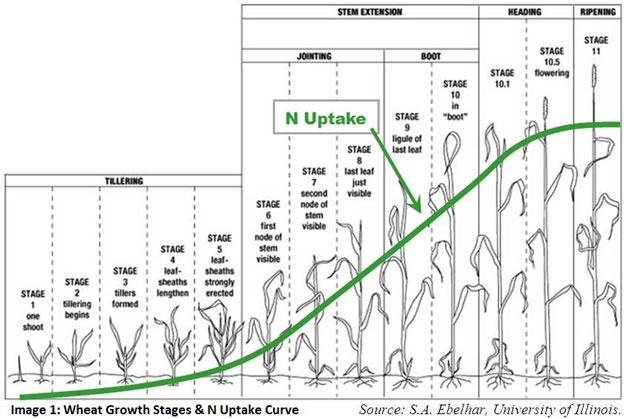Spring nitrogen applications should be guided by 4R best management practices

- March is the optimum timing for spring nitrogen fertilization of winter wheat.
- Split timing may provide additional yield benefit, especially with soil types and weather conditions that favor N loss.
- The maximum nitrogen rate for high-yield wheat is 90-150 pounds total N per acre, with economic optimum dependent on market prices of wheat and nitrogen.
- Dry urea or liquid UAN sources of nitrogen both perform equally well. Nitrogen stabilizers will prevent volatilization and denitrification losses, making more nitrogen available when the plant needs it most.
- Consider adding a source of sulfur like AMS or ATS to correct sulfur deficiencies.
The goal of spring nitrogen fertilization of wheat is to have adequate nitrogen in the rooting zone before jointing begins, when nitrogen uptake rates begin to increase sharply (see Image 1). Spring nitrogen applications should be guided by 4R best management practices that optimize economics and minimize environmental impact. Consideration should be given to product form, application rate, application timing, and placement method.
Timing is perhaps the most important and also the most often compromised of these factors. Favorable late winter field conditions may open windows of opportunity for field work that are too good to pass up. Ideal timing is influenced by several factors, including soil type, soil drainage, degree of tillering, and environmental conditions. For soils that are prone to loss, either by leaching or denitrification, applications should ideally be delayed until green up. If tillers are adequate, then single application timing can perform just as well as split applications. The optimal timing for highest yield with a single application is at Feeke’s 5, usually in March. Single applications that occur in February or January will typically result in lower yields and more N loss. The exception is when wheat is weakly tillered, in which case a very early top-dress application will prompt the wheat to produce more tillers and drive up yield potential. If an early application is made to support tiller formation, then a second split application will likely be needed to ensure maximum grain yield.
Nitrogen rate recommendations for wheat vary by state. As an example, Illinois recommends up to 90 total lbs N per acre on low OM soils and as much 150 total lbs N per acre on high OM soils, with economic optimal rates dependent upon prices of wheat grain and nitrogen (see Image 2). Keep in mind that higher total N rates increase the risk for lodging, especially with lush fall growth, and should be split-applied to ensure that some nitrogen is applied early. Modern high management wheat systems commonly split apply nitrogen, with about 40-60 lbs of N per acre at Feeke’s 3 (late February or early March), followed by 50-90 lbs of N per ac at Feeke’s 5 (mid-late March). Research by University of Illinois has demonstrated that application rates may be reduced by 10% on high OM soils when using either a single late spring application or split application.
Nitrogen stabilizers (NBPT, DCD, nitrapyrin, and combination products) should be considered with N applications to wheat, especially in environments with higher loss potential to leaching and denitrification and with early timing. Yield response to split timing and stabilizers will be greater on soil types prone to N loss and under wet, warm weather conditions. High OM soils are generally less sensitive to spring N timing and less responsive to split applications.
The most common forms of nitrogen fertilizer used on wheat in the spring are dry urea and UAN, and both are equally effective. Slow-release forms of nitrogen protect against N loss and tend to produce higher yields, especially with earlier applications. Slow release nitrogen can be blended with urea to reduce overall nitrogen costs and balance nitrogen availability. Foliar injury is a potential concern with UAN applications, so streamer nozzles are often used to reduce burn risk (see Image 3). Risk for foliar injury increases when tank-mixing with herbicides, and rates should be reduced to only 20-30 lbs N per acre in these mixes.
Finally, with lower sulfur emissions from coal-fired power plants in recent decades, soil sulfur levels are being gradually depleted in many soils. Sulfur deficiency may be more of a concern on lower organic soils that mineralize less sulfur during the season. Blending dry AMS (21-0-0-24) with urea or liquid ATS (12-0-0-26) with UAN in a ratio to deliver an additional 20-30 lbs of sulfur per acre is likely to provide a yield response where deficiencies are a known issue.


Image 3: Top Right: Streamer bar nozzles